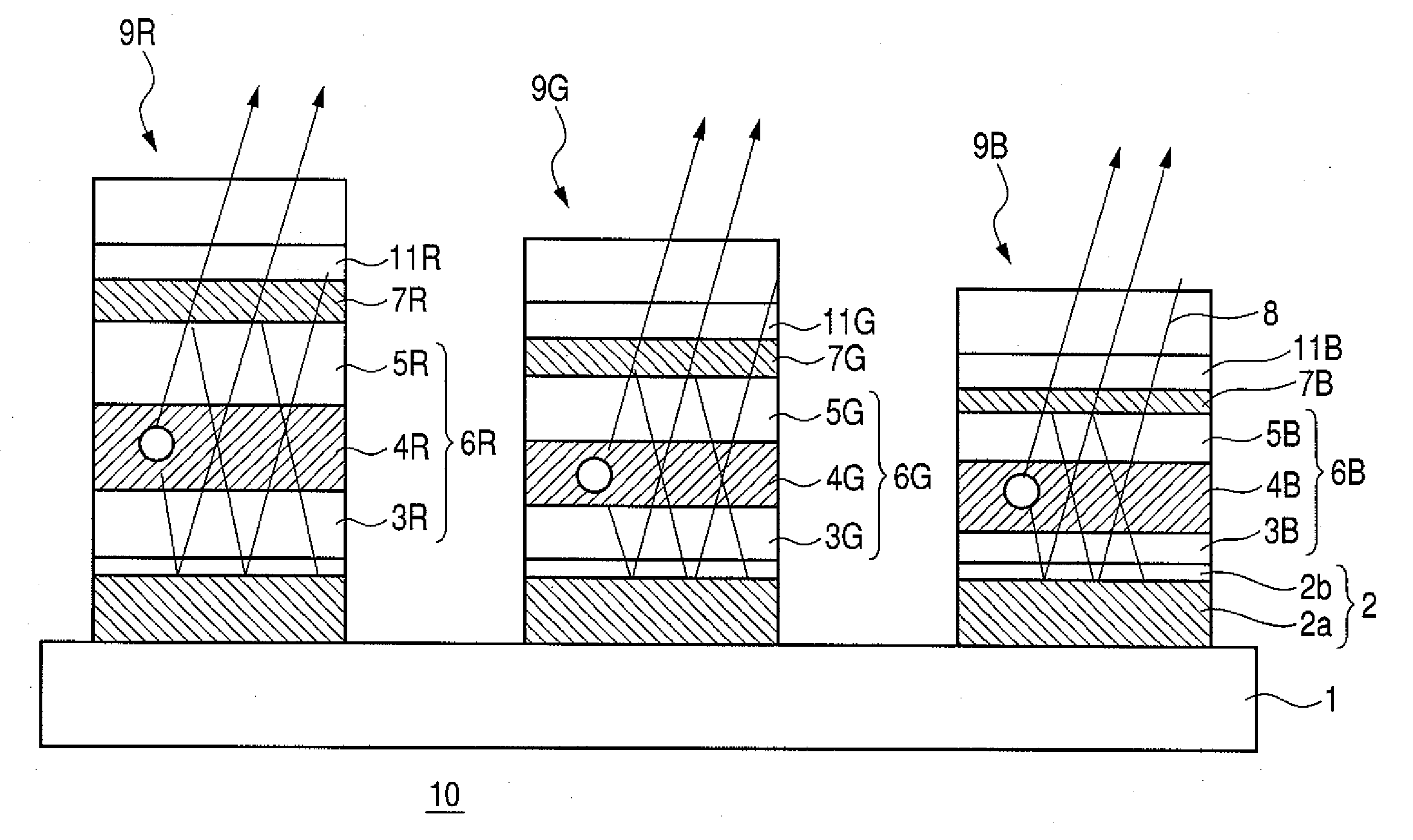Organic light-emitting device
- Summary
- Abstract
- Description
- Claims
- Application Information
AI Technical Summary
Benefits of technology
Problems solved by technology
Method used
Image
Examples
first embodiment
[0025]FIG. 1 is a partially enlarged sectional view illustrating an example of the constitution of an organic light-emitting device according to the present invention.
[0026]An organic light-emitting device 10 shown in FIG. 1 is an organic light-emitting device having organic light-emitting elements 9R, 9G and 9B showing red (R), green (G) and blue (B) emission colors, respectively, and all organic light-emitting elements each have a micro cavity structure.
[0027]Each of the organic light-emitting elements 9R, 9G and 9B has such a constitution that a first electrode 2 having a reflective surface as an anode, a hole transport layer 3R, 3G or 3B, a light-emitting layer 4R, 4G or 4B, and an electron transport layer 5R, 5G or 5B as an organic compound layer 6R, 6G or 6B, a semi-transparent layer 7R, 7G or 7B as a cathode, a transparent conductive layer 11R, 11G or 11B, and a protective layer 8 are sequentially provided on a substrate 1. The organic light-emitting device is of a top emissi...
second embodiment
[0045]In first Embodiment, the thickness of the semi-transparent layers 7R, 7G and 7B was determined in order that an organic light-emitting element for each color might have the maximum efficiency. However, when an organic light-emitting device is considered to be a display device, not only luminous efficiency but also a view angle characteristic is extremely important. In general, the view angle characteristic of an organic light-emitting element using a micro cavity structure deteriorates as resonance is intensified. To be specific, as the semi-transparent layer of the element is made thicker, a chromaticity difference due to a view angle becomes larger. In view of the foregoing, in this embodiment, an organic light-emitting device taking not only luminous efficiency but also a view angle characteristic in consideration is provided.
[0046]In order to obtain a good view angle characteristic, in all organic light-emitting elements on an organic light-emitting device, a chromaticity ...
third embodiment
[0050]An organic light-emitting device of this embodiment has the same constitution as that of first Embodiment except that a material for the semi-transparent layer 7B of the organic B light-emitting element having the worst luminous efficiency is changed.
[0051]To be specific, both the semi-transparent layers 7R and 7G are each formed of a silver film having a thickness of 10 nm, and the semi-transparent layer 7B is formed of an aluminum film having a thickness of 10 nm.
PUM
 Login to View More
Login to View More Abstract
Description
Claims
Application Information
 Login to View More
Login to View More - R&D
- Intellectual Property
- Life Sciences
- Materials
- Tech Scout
- Unparalleled Data Quality
- Higher Quality Content
- 60% Fewer Hallucinations
Browse by: Latest US Patents, China's latest patents, Technical Efficacy Thesaurus, Application Domain, Technology Topic, Popular Technical Reports.
© 2025 PatSnap. All rights reserved.Legal|Privacy policy|Modern Slavery Act Transparency Statement|Sitemap|About US| Contact US: help@patsnap.com



